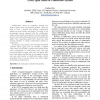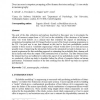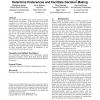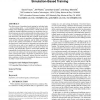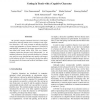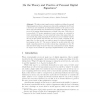IJVR
2007
14 years 24 days ago
2007
—One of the biggest obstacles for constructing effective sociable virtual humans lies in the failure of machines to recognize the desires, feelings and intentions of the human us...
AAAI
1996
14 years 2 months ago
1996
Rule induction research implicitly assumes that after producing the rules from a dataset, these rules will be used directly by an expert system or a human user. In real-life appli...
IKE
2003
14 years 2 months ago
2003
Collaboration based on computers involves two factors, human users and computer systems. When we hope to build a feasible and efficient collaborative system, we must consider both...
CARS
2003
14 years 2 months ago
2003
The goal of the data collection and analyses described in this paper was to investigate the effects of incorrect output from a CAD tool on the reliability of the decisions of its ...
AAAI
2006
14 years 2 months ago
2006
As robots become a mass consumer product, they will need to learn new skills by interacting with typical human users. Past approaches have adapted reinforcement learning (RL) to a...
ACMICEC
2008
ACM
14 years 2 months ago
2008
ACM
The world-wide-web (WWW) today consists of distinct, isolated islands of data and metadata. In the near future we expect the availability of a critical mass of data and metadata f...
ATAL
2003
Springer
14 years 6 months ago
2003
Springer
The effectiveness of simulation-based training for individual tasks – such as piloting skills – is well established, but its use for team training raises challenging technical...
HAPTICS
2005
IEEE
14 years 6 months ago
2005
IEEE
This paper outlines major challenges that we are facing in interfacing a human user with objects in the nanoworld via a haptic interface. After a review of prior efforts at haptic...
HAPTICS
2005
IEEE
14 years 6 months ago
2005
IEEE
We provide computer-animated characters with haptic interaction, allowing human users to interfere with cognitive characters. Our work presents an interface between control and an...
PKC
2009
Springer
15 years 1 months ago
2009
Springer
We take a step towards a more realistic modeling of personal digital signatures, where a human user, his mobile equipment, his PC and a server are all considered as independent pla...

